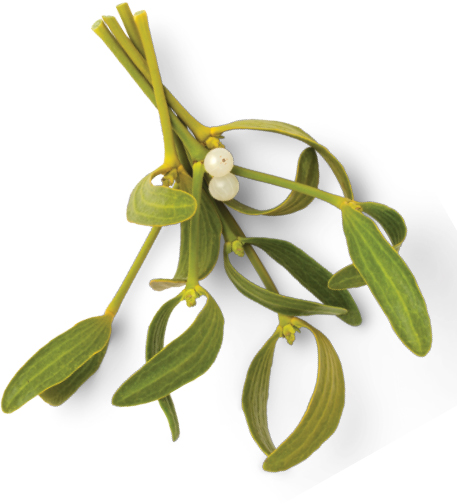Guest Editor’s Note: The use of mistletoe extract to support systemic therapy and improve quality of life for patients with cancer, though common, remains controversial. Promising results have been reported, but largely in trials that were not placebo-controlled nor properly randomized. In this installment of The ASCO Post’s Integrative Oncology series, Channing J. Paller, MD, and Alexandra Maertens, PhD, explore the role of intravenous administration of mistletoe extract (Helixor M) in treating patients with relapsed or refractory metastatic solid tumor.1

Channing J. Paller, MD

Alexandra Maertens, PhD
Background
Cancer is well known to cause both physical impairment and a markedly reduced quality of life, both from the disease itself as well as the side effects of treatment. Consequently, there has been an increased demand for complementary medicines to support treatment and improve quality of life; interest in these approaches doubled between 1970 and continues to grow.2
European mistletoe (Viscum album L) has a long history of use as supportive care during cancer treatment3 and has been widely available in integrative care clinics for decades.4 However, there have been few high-quality studies to establish its safety and efficacy and a lack of certainty about precise mechanisms.
A handful of small studies have shown improved quality of life with mistletoe extract, and one study in pancreatic cancer showed a trend toward benefit. Overall, previous systematic reviews have suggested positive effects of mistletoe extract on quality of life and chemotherapy toxicity (although no survival benefit), but these randomized controlled trials suffered from methodologic deficits.5 The quality-of-life benefits of mistletoe extract reported in other, more reliable studies6 found it improved cancer-related fatigue in a manner akin to physical activity.7,8
The growth inhibitory effects of three types of mistletoe extract—Helixor P (pine trees), Helixor M (apple trees), and Helixor A (fir trees)—were investigated in a panel of 38 human tumor cell lines in vitro.9 Helixor P showed the most potent cytotoxic activity, followed by Helixor M and Helixor A.
In vivo experiments on the antitumor activity of Helixor M showed a decreased cell proliferation rate as well as increased rates of cell necrosis and apoptosis compared with untreated mice.10 Its bioactive components cause tumor cytotoxicity in vitro9 by interfering with protein synthesis,11,12 inhibiting the cell cycle,13 and inducing apoptosis.13-16 However, these antineoplastic properties have not been evaluated in clinical trials.
In addition, mistletoe extract has been associated with antiangiogenic properties17 as well as increased cytokines and white blood cells18-20; furthermore, it has been demonstrated to simulate dendritic cells.21 The presence of multiple bioactive compounds in Helixor M makes developing a bioanalytic method for analyzing plasma or serum levels a challenge. To date, no certified methods are available.
Although Viscum album L is not an approved cancer treatment, because of its cytotoxicity, antiangiogenic properties, and immunomodulation activities, it has the potential both to reduce the adverse events of traditional therapies and improve quality of life.22
Clinical Studies

Despite its long use as a supportive treatment in cancer management, the efficacy and safety of mistletoe extract are uncertain. A phase I trial assessed intravenous Helixor M in 21 heavily pretreated patients with advanced solid tumors experiencing disease progression on at least one line of chemotherapy (and had a life expectancy of more than 3 months).1 These patients received escalating doses of intravenous mistletoe three times a week to determine its safety, maximum tolerated dose, and recommended phase II dosing. Dose frequency as well as starting and maximum doses were informed by an older phase I trial of intravenous Helixor P.23 Tumor marker kinetics and quality of life were also assessed.
Study Results
In this small study, Helixor M demonstrated disease control and improved quality of life with manageable toxicity.1 Despite a lack of objective responses, stable disease was observed in five patients receiving a dose within the maximum tolerated dose (at a median of 15 weeks), and three patients experienced tumor reduction. The disease control rate (percentage of complete or partial response and stable disease) was found to be 23.8%. Positive baseline serum carcinoembryonic antigen levels (CA-125) showed a slower rate of increase at higher doses, suggesting a dose-response effect.
Though the results did not reach statistical significance, at 4 weeks, median quality of life by Functional Assessment of Cancer Therapy–General increased from 79.7 to 93. By the end of treatment, patients’ quality of life improved in total score and in physical, social/family, and functional well-being.
The overall safety profile was manageable, with fatigue, nausea, and chills being the most reported treatment-related adverse effects. Three patients (14.7%) discontinued treatment because of a dose-limiting toxicity; four associated adverse events were considered related to treatment. One patient, who was taking the maximum tolerated dose, discontinued treatment because of fatigue.
Guest Editor

Dr. Mao is the Laurance S. Rockefeller Chair in Integrative Medicine and Chief of Integrative Medicine Service at Memorial Sloan Kettering Cancer Center, New York.
Furthermore, the observed safety profile of Helixor M resembled that of Helixor P (reported by Huber et al23). Both phase I trials had 21 patients with advanced cancer treated with mistletoe extract.1,23 The maximum tolerated dose was not reached with Helixor P, although the maximum tolerated dose for Helixor M was determined to be 600 mg three times a week. However, this Helixor M study required heavily pretreated patients who had experienced disease progression after at least one systemic therapy, potentially causing lower overall tolerability.1
Temporary improvement of tumor markers and stable disease followed by slow disease progression were also observed in patients receiving Helixor P.23 Additionally, elevated serum cytokine levels after treatment may indicate possible immune activation.24 Overall, these cytokines represent antitumor serum profiles in patients with stable disease.25 However, it is not clear whether this is a direct activity of mistletoe extract, as more mechanistic-oriented studies are required.
Conclusion
An intravenous mistletoe extract demonstrated common, manageable toxicities while providing some measurable effects on disease control and quality of life. It’s possible that the maximum tolerated dose may be dependent on dose frequency and disease severity. Despite a lack of objective responses, stable disease and tumor shrinkage were observed in a heavily pretreated solid tumor population (one to six lines of prior therapy). Moreover, a trend toward stabilization of tumor markers at higher doses was observed, suggesting higher doses may have led to better responses in less severely ill patients. Finally, the suggestions of improved quality of life may enable longer therapy for patients with heavily pretreated advanced solid tumors.
Future phase II trials are warranted to further explore the optimal timing and dose frequency of intravenous mistletoe extracts. Studies of combined mistletoe extract infusions with chemotherapy, immune therapy, or targeted therapy are also needed to assess the impact of such combinations on survival, tolerability, treatment time, patient quality of life, and functional immune correlates.
Future phase II trials are warranted to further explore the optimal timing and dose frequency of intravenous mistletoe extracts.— Channing J. Paller, MD, and Alexandra Maertens, PhD
Tweet this quote
Dr. Paller is Director of Prostate Cancer Clinical Research and Associate Professor of Oncology at Johns Hopkins Medicine, Baltimore. Dr. Maertens is Assistant Scientist in Environmental Health and Engineering at Johns Hopkins Bloomberg School of Public Health, Baltimore.
DISCLOSURE: Dr. Paller has served as a consultant for Bayer, Janssen, and Helixor, and has received research grants from Lily, Merck, and AstraZeneca. Dr. Maertens reported no conflicts of interest.
REFERENCES
1. Paller CJ, Wang L, Fu W, et al: Phase I trial of intravenous mistletoe extract in advanced cancer. Cancer Res Commun 3:338-346, 2023.
2. Horneber M, Bueschel G, Dennert G, et al: How many cancer patients use complementary and alternative medicine: A systematic review and metaanalysis. Integr Cancer Ther 11:187-203, 2012.
3. Mansky PJ: Mistletoe and cancer: Controversies and perspectives. Semin Oncol 29:589-594, 2002.
4. Kienle GS, Mussler M, Fuchs D, et al: Intravenous mistletoe treatment in integrative cancer care: A qualitative study exploring the procedures, concepts, and observations of expert doctors. Evid Based Complement Alternat Med 2016:4628287, 2016.
5. Freuding M, Keinki C, Micke O, et al: Mistletoe in oncological treatment: A systematic review: Part 1: Survival and safety. J Cancer Res Clin Oncol 145:695-707, 2019.
6. Loef M, Walach H: Quality of life in cancer patients treated with mistletoe: A systematic review and meta-analysis. BMC Complement Med Ther 20:227, 2020.
7. Kienle GS, Kiene H: Influence of Viscum album L (European mistletoe) extracts on quality of life in cancer patients: A systematic review of controlled clinical studies. Integr Cancer Ther 9:142-157, 2010.
8. Pelzer F, Loef M, Martin DD, et al: Cancer-related fatigue in patients treated with mistletoe extracts: A systematic review and meta-analysis. Support Care Cancer 30:6405-6418, 2022.
9. Kelter G, Schierholz JM, Fischer IU, et al: Cytotoxic activity and absence of tumor growth stimulation of standardized mistletoe extracts in human tumor models in vitro. Anticancer Res 27:223-233, 2007.
10. Beuth J, Ko HL, Schneider H, et al: Intratumoral application of standardized mistletoe extracts down regulates tumor weight via decreased cell proliferation, increased apoptosis and necrosis in a murine model. Anticancer Res 26:4451-4456, 2006.
11. Stirpe F, Sandvig K, Olsnes S, et al: Action of viscumin, a toxic lectin from mistletoe, on cells in culture. J Biol Chem 257:13271-13277, 1982.
12. Sweeney EC, Palmer RA, Pfüller U: Crystallization of the ribosome inactivating protein ML1 from Viscum album (mistletoe) complexed with beta-D-galactose. J Mol Biol 234:1279-1281, 1993.
13. Harmsma M, Grommé M, Ummelen M, et al: Differential effects of Viscum album extract IscadorQu on cell cycle progression and apoptosis in cancer cells. Int J Oncol 25:1521-1529, 2004.
14. Janssen O, Scheffler A, Kabelitz D: In vitro effects of mistletoe extracts and mistletoe lectins: Cytotoxicity towards tumor cells due to the induction of programmed cell death (apoptosis). Arzneimittelforschung 43:1221-1227, 1993.
15. Kovacs E, Link S, Toffol-Schmidt U: Cytostatic and cytocidal effects of mistletoe (Viscum album L.) quercus extract Iscador. Arzneimittelforschung 56:467-473, 2006.
16. Elluru S, Duong Van Huyen JP, Delignat S, et al: Molecular mechanisms underlying the immunomodulatory effects of mistletoe (Viscum album L.) extracts Iscador. Arzneimittelforschung 56:461-466, 2006.
17. Elluru SR, Duong Van Huyen JP, Delignat S, et al: Antiangiogenic properties of viscum album extracts are associated with endothelial cytotoxicity. Anticancer Res 29:2945-2950, 2009.
18. Hostanska K, Hajto T, Spagnoli GC, et al: A plant lectin derived from Viscum album induces cytokine gene expression and protein production in cultures of human peripheral blood mononuclear cells. Nat Immun 14:295-304, 1995.
19. Hajto T, Hostanska K, Frei K, et al: Increased secretion of tumor necrosis factors alpha, interleukin 1, and interleukin 6 by human mononuclear cells exposed to beta-galactoside-specific lectin from clinically applied mistletoe extract. Cancer Res 50:3322-3326, 1990.
20. Oei SL, Thronicke A, Schad F: Mistletoe and immunomodulation: Insights and implications for anticancer therapies. Evid Based Complement Alternat Med 2019:5893017, 2019.
21. Elluru SR, Duong van Huyen JP, Delignat S, et al: Induction of maturation and activation of human dendritic cells: A mechanism underlying the beneficial effect of Viscum album as complementary therapy in cancer. BMC Cancer 8:161, 2008.
22. Kienle GS, Kiene H: Die Mistel in der Onkologie: Fakten und Konzeptionelle Grundlagen. Stuttgart, Germany; Schattauer; 2003.
23. Huber R, Schlodder D, Effertz C, et al: Safety of intravenously applied mistletoe extract: Results from a phase I dose escalation study in patients with advanced cancer. BMC Complement Altern Med 17:465, 2017.
24. Kunz M, Toksoy A, Goebeler M, et al: Strong expression of the lymphoattractant C-X-C chemokine Mig is associated with heavy infiltration of T cells in human malignant melanoma. J Pathol 189:552-558, 1999.
25. Dinarello CA, Novick D, Kim S, et al: Interleukin-18 and IL-18 binding protein. Front Immunol 4:289, 2013.

